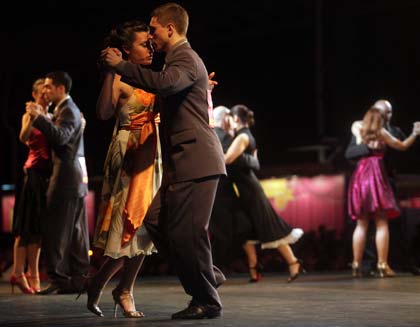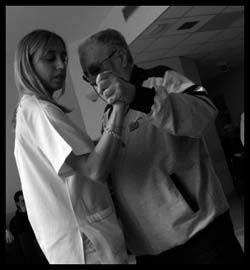By
The benefits of Argentine tango dancing

his article will describe the existing peer review research on the benefits of Argentine tango dancing in general, and specifically, for persons with disabilities. However, the review is not exhaustive, and the reader is invited to contact the author with studies or information that they feel should be included in the review at Patricia.mckinley@mcgill.ca.
Why tango? Those of you who already tango know why you tango, but perhaps you might like to know some of the measured benefits to this wonderful dance and why it is considered by health care professionals to be an ideal exercise to benefit social, mental and physical well-being across the ages. In this brief review, I will attempt to cover the main benefits of this glorious activity.
Dance targets 6 main areas considered to be important for high quality of life and successful aging:
1. physical exercise
2. social satisfaction
3. spirituality and mindfulness
4. cognition
5. meaningfulness
6. emotional and educational health
While all types of dance confers some types of benefits, Argentine tango dancing, in particular, has documented proof that these areas are improved in both healthy and disabled populations. As well, it does seem to confer more benefits than ballroom dancing, according to Drs. Hackney and Earhart. Many researchers feel that the combination of tango music, sense of accomplishment, and attention required to follow improvisational moves make tango very special for improving both cognitive and physical health. In addition, since Argentine Tango is primarily a walking dance, it is actually easier to learn and perform than many other dances and, since changing partners is encouraged, it is more accommodating for getting to know the community of dancers. Lets look at these areas individually to see specific effects of Argentine Tango.
1. Physical Exercise
• Tango is good for cardiovascular health.
Intensity can be modified to ensure that it is an endurance exercise. Indeed, in Argentina, Drs. Comasco and Peidro have shown in a hospital setting that Tango can be used to improve cardiovascular fitness in persons who have had a cardiac incident or a heart attack.
• Tango increases mobility, balance, stride length and core strength.
These changes have been demonstrated not only in healthy individuals, but in those at risk for falls by Dr McKinley and colleagues, in persons with Parkinson’s disease by Drs Hackney and Earhart, in persons with visual impairment by Dr Hackney, and, in a case study, for a person post-stroke (ref name).

2. Social Satisfaction
• Interaction with people with similar interests.
Partnered tango dance has been found to be an important activity which is engaging, and is self-promoting, because of the amount of enjoyment and identification within the group of people with similar interests and goals by Drs Kreutz and Tateo.
 • Interaction with people with similar goals.
• Interaction with people with similar goals.
According to researchers McKinley, Rabinovich, Pinniger, and Tesmijian, individuals with disabilities related to Parkinson’s disease, visual impairment or depression have expressed a sense of common goals that include improving mobility, a sense of connectedness and understanding with others and the ability to learn a new activity while decreasing isolation.
3. Spirituality and mindfulness
• Tango induces a state of flow and spirituality.
Flow is a state of mind where the action is so pleasurable that you want to do it again and again and do not want to stop. This feeling has been expressed by the following groups:
* Elderly at risk for falls: («Oh when I hear that music, I just want to dance, dance, dance»)
* Parkinson’s disease: («Other treatments do not engage me, I don’t know why. They do not catch my body or my mind. It is like eating without spices. There is something missing. I stopped going to other treatments, but for Tango, I am never absent.»)
* Self-diagnosed depression («I wish I could dance all day every day»)
* Visual impairments («Once the music starts, and I begin to dance, I do not want to stop; I feel young and whole again»)
Spirituality is often expressed in terms of tango as a holistic activity
(«In this program they do not only take care of our bodies, they also take care of our spirits. While we dance we are people…. not sick people»).
• Mindfulness is improved.
In a series of studies, Drs Pinniger, McKinley and colleagues have demonstrated that Argentine Tango helps individuals focus on the present and the task at hand. Because of the importance of the interactions between partners for step execution, dancers must focus on the present task at hand. There is no time to ruminate about other issues or problems that may be troubling them at the present. This factor is so strong, that the enhancement of mindfulness with tango has been to shown to be greater than meditation or resistance training in persons with self-diagnosed depression.
4. Cognition
• Specific cognitive skills may be improved.
In persons at risk for falls, Jacobson and McKinley have found that the ability to do two things at once, such as navigating in space and being in synchrony with your partner (Dual tasking) is improved. There are indications that working memory may also be improved.
• Dance appears to be an effective exercise to counteract dementia.
In a large epidemiological study, Dr Verghese and colleagues ascertained that the major physical activity that seemed to protect against Alzheimer’s disease was dancing.
5. Meaningfulness
• Purposefulness of Tango.
Dancers not only want to learn the steps, but execute them gracefully and to be in synchrony with their partner. They often express a specific purpose for doing tango. They want to challenge themselves to do something new; they want to have fun, to meet new people.
• Tango is goal directed.
Anyone who engages in a tango class generally has a specific goal in mind. For healthy individuals, it might be social interactions, the ability to dance the tango at a wedding, a trip to Argentina, etc. For persons with disabilities, these goals are generally related to the disability. Persons will express specific goals such as I want to lose my fear of falling; I want to walk better; I want to feel better about myself. Because tango instruction can be so easily gauged to a person’s ability, and the essence of tango is walking, people easily perceive that they are fulfilling these goals.
 6. Emotional and Educational Health
6. Emotional and Educational Health
• Tango provides an avenue for learning new skills.
For example, many individuals with disabilities expressed this sentiment:
«When I started learning tango I realized that I still can do and learn things. So I feel capable again. If I can learn tango I am sure I can learn other things too».
• Emotional responses are facilitated by tango music and enhanced by dancing.
Brown and colleagues have shown that MRIs of brain activity during the playing of tango music, or visually watching tango dancing (to music) have exhibited specific activity in the brain related to sensory motor integration and pleasurable emotion. These responses may be enhanced by executing tango-like movements while listening to music. As well, it seems that tango music enhances the release of testosterone, this response seems to be increased when dancing to tango music, both in men and women.
Implementation of tango classes for persons with disabilities. Here are a few critical elements to ensure that the tango classes provide enjoyment and support for the participants.
• Skilled partners preferable: volunteer Tangueros are preferable as partners, as there is much more enjoyment and sense of accomplishment when dancing with skilled partners.
• Music should have a strong and predictable beat: a very obvious strong and clear rhythm is critical, as an identifiable strong rhythm engages many parts of the brain and helps the person to execute the walk and other steps.
• Dance floor is spacious: sufficiently large with no barriers to avoid, and with clear and differential audio speakers in order to facilitate navigation around the room for visually impaired.
• Social break during the class: participants like to have refreshments and time to talk and rest during the middle of the class. They look forward to socializing and also to resting a bit.
• Dedicated dance classes: while some individuals enjoy coming to regular tango events, others prefer to have dedicated classes/events for themselves as they have expressed fearfulness in not being able to perform with regular Tangueros. Thus, one option might be to hold specific hours of class or free dance for persons with disabilities.
Patricia McKinley, PhD, School of Physical and Occupational Therapy, McGill University. http://www.mcgill.ca/spot/faculty/mckinley